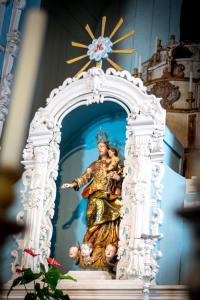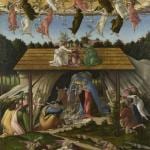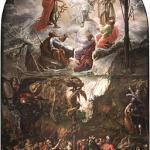
In grad school, I read a book called Veiled Threats by Michael Carroll, a Canadian scholar has written a number of books about popular/folk Catholicism in several different cultures. This book, like its predecessor Madonnas that Maim, focused on the role of the Virgin Mary in southern Italian Catholicism from the fifteenth century to the present. Carroll describes a common practice in southern Italy of covering statues of the Virgin Mary (and I believe sometimes other statues as well) with veils and only unveiling them for particular devotional purposes. People did this because they believed that such statues could harm or even kill if left permanently unveiled. They were sites of divine power and this power could be destructive as well as beneficent.
According to Carroll, the Catholic hierarchy after the Council of Trent sought to suppress this kind of Marian piety. It was not in line with the official Catholic understanding of Mary as someone whose power rests solely in her intercessory role, someone who is entirely subject to God and points us to her Son as the savior of the world. And at the time, as a Protestant who was worried that Catholics “worshiped Mary,” I was very much in sympathy with the authorities. Indeed, it was reassuring to know that the Catholic hierarchy was aware of the “dangers” of the “wrong” kind of Marian piety.
Now I think differently. I have a lot of difficulties with Catholicism, going on four years after finally swimming the Tiber in 2017. But devotion to Mary is not one of them. On the level of daily piety, I’m not hyper-Marian. I pray some form of the Liturgy of the Hours more often than the Rosary. A lot of traditional Marian piety just doesn’t do a lot for me emotionally, because it’s not the way I was brought up. And I do have a problem with forms of Marian piety that make her seem like the merciful one who can be counted on to restrain an angry Jesus. I also have questions about the dogmatizing of some of the Marian doctrines and about the way in which the concept of Mary’s virginity interacts with some troubling traditional ideas about sexuality and women’s bodies.
But can we have too much devotion to Mary? I think not. Is Mary a goddess in Catholicism? In my more heretical moments I think, “if only.”
In 2014, on the verge of moving to Kentucky after losing my teaching job in Indiana, I had a dream about Mary. She told me to move to Kentucky and she would be with me. I woke with a marvelous feeling of relief and hope that I had not had for several years. Of course it could well have been just my subconscious. But it mattered, and it still matters.
Gentle Mary, meek and mild
It also matters, I think, that the Mary of Catholic popular devotion has not always been the meek and obedient maiden of official piety. Today, feminist Catholics seek to reclaim Mary from the sentimentalism of “traditional” Catholic devotion. Contemporary Catholics point out, rightly, that the Magnificat is a song of the coming of the Kingdom and the overturning of the proud. Sometimes more conservative Catholics push back at this attempt to turn Mary into a kind of feminist “strong woman.”
But Carroll’s research shows that within popular Catholicism there is already a tradition of Mary as a being of terrifying power. It’s not simply an invention of modern feminism.
Of course, the Mary of Southern Italian folk piety (and other versions of Catholic folk piety in which Mary is a powerful and commanding presence) is not simply the “strong woman” of a feminist interpretation who stands up against the patriarchy. In the stories Carroll collected, Mary’s “victims” might themselves be women. Her vengeful actions could be seen as amoral, the actions of a supernatural being concerned with her own honor and dignity. The energy believed to emanate from some statues of the Virgin is a kind of magical force, a “mana” not necessarily connected to some kind of moral principle.
So we shouldn’t be too quick to take this “popular Mary” as a stand-in for modern feminist concerns. Nor should we dismiss the legitimate concerns with seeing Christian saints as akin to deities. Obviously it is basic Christian teaching that there is one true God and that saints derive their power from God. They act in ways that seem “godlike” because, as Orthodox teaching would put it, they have been “deified” through the action of the Holy Spirit. And the one in whom all things hold together is the Logos who became incarnate as Jesus of Nazareth. Mary and all the saints derive their spiritual importance from him and exercise their power by way of intercession, not as independent deities.
Divine electricity
And yet. . . . there’s plenty of Biblical language that speaks of God acting in “jealous” and “wrathful” ways. There are OT stories, like the story of Nadab and Abihu or Uzzah touching the Ark, in which divine power sees to act like a kind of “electricity” to “zap” people who treat sacred objects with disrespect. Certainly God is more than a kind of cosmic energy field. But also not less.
The same is true of the saints. The deifying power of the Spirit wraps them, so to speak, in the divine energy. To touch them is in some sense to touch God and come in contact with divine power. Hence the longstanding Christian tradition (with Biblical roots and contrasting with the Greco-Roman pagan horror of dead bodies) of venerating even their bones and other relics.
As a former Protestant, I get why modern American Catholics want to play down the “magical” elements of the Tradition and emphasize that saints are role models of faith and obedience and that all their power comes from their intercession. And all of that is true. But it’s not the whole truth. Catholicism is much wilder and more magical than that. God is not a tame lion. And the saints are not tame either.
The least tame of all
And least tame of all the saints is the Lady clothed with the sun, who tramples on the serpent. Catholic tradition, in fact, speaks of her as the Ark of the Covenant. (The allegorical interpretation of Scripture is another part of the tradition about which I think we should be a lot less reticent.) So the idea of divine power coming out from her images and smiting people isn’t as crazy, or as non-Biblical, as one might think.
I don’t, of course, think that the Blessed Virgin smites people capriciously or just to uphold her own importance. But I do think that we veil her too much.
We veil her under sentimental piety. We veil her under the fear of being thought idolatrous in a largely Protestant society. We veil her under patriarchal assumptions about what her virginity and her motherhood mean. We veil her under the projection of our own image of what a perfect woman is like. We veil her, most terribly of all, under the contempt that far too many of us male Catholics feel for real women.
Perhaps it’s time to unveil her and let her smite.












